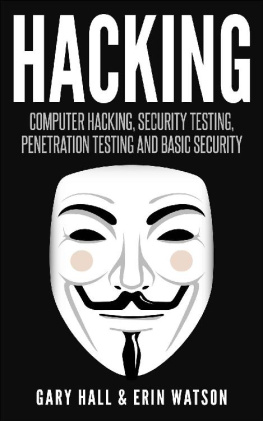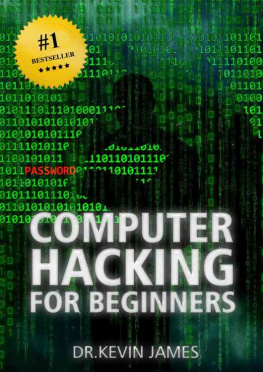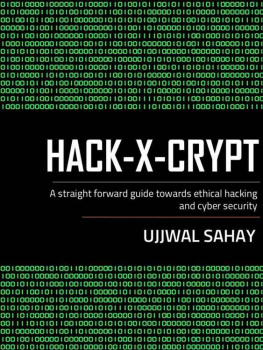Page List
WHITE AND BLACK HAT HACKERS

Published in 2017 by The Rosen Publishing Group, Inc. 29 East 21st Street, New York, NY 10010
Copyright 2017 by The Rosen Publishing Group, Inc.
First Edition
All rights reserved. No part of this book may be reproduced in any form without permission in writing from the publisher, except by a reviewer.
Library of Congress Cataloging-in-Publication Data
Names: Porterfield, Jason, author.
Title: White and black hat hackers / Jason Porterfield.
Description: First edition. | New York : Rosen Publishing, 2017. | Series: Cryptography : code making and code breaking | Includes bibliographical references and index.
Identifiers: LCCN 2016017849 | ISBN 9781508173144 (library bound)
Subjects: LCSH: Penetration testing (Computer security)Juvenile literature. | Computer securityJuvenile literature. | Computer crimesJuvenile literature. | Computer crimesPreventionJuvenile literature.
Classification: LCC TK5105.59 .P66 2017 | DDC 005.8dc23
LC record available at https://lccn.loc.gov/2016017849
Manufactured in China
C ONTENTS
C HAPTER 1
H ACKING S E ARLY D AYS
C HAPTER 2
T HE S HADY S IDE OF S ECURITY
C HAPTER 3
M ISCHIEF AND T HREATS
C HAPTER 4
A TTACK AND C OUNTERATTACK
C HAPTER 5
G ATHERING IN THE S HADOWS
I n many ways, computers are wonderful tools. They store huge amounts of information, control important processes, and keep systems running smoothly. Computers can solve problems and find solutions far faster than humans, and they can be used to help predict outcomes of everything from global warming to baseball games. Specialized computers control transportation systems, computer networks, and even financial transactions.

Famed hacker Barnaby Jack once worked as a white hat hacker, testing the security of medical devices such as insulin pumps for technical weaknesses.
Computers are also tempting targets for curious people and criminals. Hackers are individuals who gain access to computers or networks without official permission. They may be computer enthusiasts who want to find out how security systems work, specialists trying to strengthen the network, thieves intent on causing damage, or activists trying to prove a point.
Black hat hackers are those who want to steal information or cause damage. The name comes from old Westernsthe movies, dramas, or novels in which bad guys such as bank robbers or cattle rustlers wear black hats, and the sheriff and other cowboy heroes wear white hats.
All hackers have a deep knowledge of computers and networks. They are curious about the way systems are set up and how programs are coded. However, white hat hackers are interested in building systems and making them stronger, while black hats want to tear them apart. They exploit security flaws to steal information and cause chaos. They tamper with systems and write viruses designed to shut networks down. Gray hats fall somewhere in between, as they access computers without permission but rarely do so with criminal intent.
Where black hat hackers want to break into systems, white hat hackers are concerned with making data more secure. They are often employed to help companies expose vulnerabilities in their security systems and make them more secure. Some of these ethical hackers were once black hat hackers who were interested in violating or compromising security, often to steal money or information.
Legally, the difference between white hat and black hat hackers is simple: white hat hackers have been given permission to break into systems to perform a job. Cracking into a network without permissioneven if ones intentions are goodis still considered illegal and falls into the shady area of gray hat hacking.
Hacking as a hobby and pastime blossomed during the 1980s. Personal computers were becoming more common in businesses and homes. Criminals were also becoming aware that valuable data was being stored on computers and that they could steal money, software, and secrets by hacking into those computers. The introduction of the World Wide Web in the 1990s opened up greater possibilities for theft and mischief. Today, computers and the internet play a huge role in peoples lives, from providing vital services to delivering entertainment. It is more important than ever for white hat hackers to keep the black hats at bay.
C HAPTER 1
H ACKING S E ARLY D AYS
H acking dates back to the late 1800s, when people would gain unauthorized access to early telephone networks and disrupt telegraph messages. Even some of the earliest radio broadcasts were intercepted by people other than their intended recipients. During the 1960s, hackers were people who could find shortcuts within the huge mainframe computers in use at the time and make the machines perform unexpected tasks. Today, hackers try to access computers through networks that span the globe.
T RAIN S ETS TO M AINFRAMES
The practice of hacking can be traced back to the earliest telegraph networks, which were first developed in the 1840s and could be used to send messages over long distances in a matter of minutes. People sometimes tapped telegraph lines to get the messages. This practice became an easy way for spies to steal information about companies, governments, and armies. People eventually started using secret codes so that important messages could remain confidential.
Early experiments in radio broadcasts were also plagued by people listening in without permission. In 1895, Italian inventor and radio pioneer Guglielmo Marconi invented the first practical means of sending telegraph messages using radio waves. During a public demonstration held in London, England, in 1903, a magician and inventor named John Nevil Maskelyne intercepted Marconis radio frequencies and delivered an insulting message to the audience. The incident embarrassed Marconi and proved his technology was not as secure as he claimed.

Guglielmo Marconis wireless devices paved the way for modern radio and cell phones. However, the messages sent using his radio transmitters were not as secure as he advertised.
Punch-card computers were also vulnerable to hackers, even though they were not connected to any networks. During World War II, a French punch-card computer expert and government official named Ren Carmille and several others altered equipment to disrupt the pro-Nazi governments efforts to track Jewish citizens. Their sabotage efforts went undetected from 1940 to 1944 and likely saved thousands of lives.
T HE O RIGINS OF H ACKER C ULTURE
The word hacking was first associated with technology through the experiments of a club at the Massachusetts Institute of Technology (MIT). The Tech Model Railroad Clubs members modified electric train sets to make them faster, a process they called hacking. Some of the clubs members were also interested in computers and in finding new ways to make them work. The computers that were available at the time were massive machines, each big enough to fill a room. These mainframes were accessible only on-site. They were also very expensive and generally owned by only governments, schools, and large companies. In many cases, access to the machines was limited to just a few well-trained specialists. Several members of the club impressed the manager of the MIT Artificial Intelligence Lab enough that he gave them access to the labs machines. They began calling themselves the Signal and Power Committee and took an interest in creating programming tools.




















